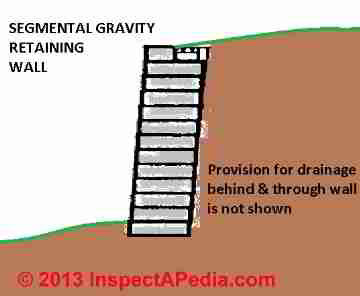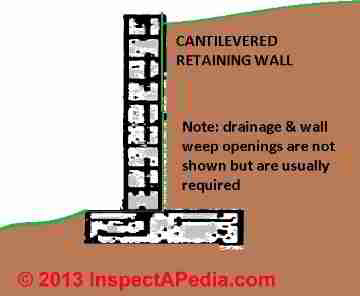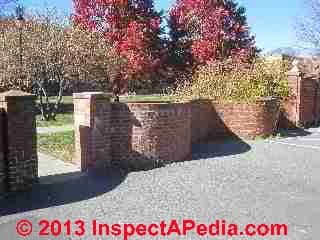 Retaining Wall & Barrier Wall Definitions
Retaining Wall & Barrier Wall Definitions
Definitions of types of retaining walls & privacy wall construction & design terminology
- POST a QUESTION or COMMENT about retaining wall types, designs, materials, and retaining wall guard railings & building codes
Retaining wall & privacy wall definitions:
This article defines retaining wall, barrier or privacy wall, and key retaining wall terms such as wall surcharge and types of retaining wall construction.
This article series describes types of privacy walls, retaining walls and retaining wall guard railing requirements, guard railing construction and building codes, and critical safe-construction details for retaining wall guardrails. We include definitions of important retaining wall terms such as wall surcharge, and we provide diagnostic descriptions & photographs of types of damage to retaining walls & privacy walls.
Our page top photo illustrates a serpentine brick barrier or privacy wall on the Vassar College campus in Poughkeepsie, NY. This wall depends on its footings and wall top surface seal to protect the wall from frost damage.
InspectAPedia tolerates no conflicts of interest. We have no relationship with advertisers, products, or services discussed at this website.
- Daniel Friedman, Publisher/Editor/Author - See WHO ARE WE?
Definitions of retaining wall, retained wall height, exposed retaining wall height and retaining wall surcharge loading
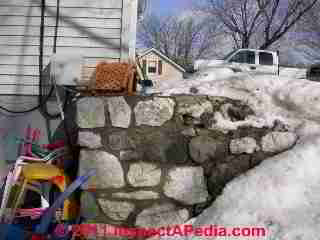 Retained Wall Height at a retaining wall is the vertical distance measured from the bottom of the footing to the finish grade at the top of the wall (i.e. upper soil grade). This is the height referred to in UBC §106.2, item 5 and it includes the wall and depth of footing below grade.
Retained Wall Height at a retaining wall is the vertical distance measured from the bottom of the footing to the finish grade at the top of the wall (i.e. upper soil grade). This is the height referred to in UBC §106.2, item 5 and it includes the wall and depth of footing below grade.
Exposed Retaining Wall Height at a retaining wall is the vertical distance measured from the finish grade at the bottom of the wall (i.e. lower soil grade) to the finish grade at the top of the wall (i.e. upper soil grade). Exposed retaining wall height does not include the wall and depth of footing below grade.
In areas where the footing for a retaining wall is below the frost line, there may be considerable difference between the retained wall height and the exposed retaining wall height.
Retaining Wall Surcharge [loading on a retaining wall] is a vertical load imposed on the retained soil that may impose a lateral force against the retaining wall in addition to the lateral earth pressure of the retained soil.
Our retaining wall photo (above left) illustrates a retaining wall with a higher than anticipated surcharge from soil, piled-up snow when the driveway and parking area were snow-plowed, and vehicle loading. (That's my white pickup truck at upper right but other vehicles were parked quite close to the retaining wall.)
Frost push from water behind this inadequately-drained retaining wall added to the lateral or horizontal force and had caused recurrent cracking, stone dislocation, and wall creep.
Examples of retaining wall surcharges that increase wall loading include:
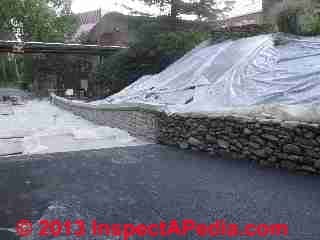
- Sloping retained soil (photo at left)
- Structure footings supported by the retained soil - a structure whose weight bears on soils close to the retaining wall
- Adjacent vehicle loads supported by the retained soil - driving or parking on soils behind and close to the retaining wall
- Solid fences that are attached (or directly adjacent) to a retaining wall also impose additional lateral forces on a retaining wall when wind pressures act on the fence. [3]
- Additional loads from water and frost [added by DJF] in wet or freezing climates may not be considered retaining wall surcharge by some engineers but they are certainly added forces on the wall. Wet weather and frost can add enormous additional surcharge to a retaining wall, particularly if adequate drainage behind the wall was omitted.
Comparing a Cantilevered Retaining Wall and a Segmental Gravity Type Retaining Wall
Our sketches below, adapted from Folsom CA building department drawings, illustrate the differences in how a segmental gravity retaining wall and a cantilevered retaining wall are supported.
The segmental gravity wall depends chiefly on gravity - the weight of the stacked wall segments, to keep the wall in place and to hold back the earth load behind the wall. You can see that a segmental gravity wall is usually built staggered design, leaning back into the hill for added strength.
In contrast, a cantilevered retaining wall depends on the stability of its footing, possibly anchors into the soil behind the wall, and its internal strength or reinforcements to hold back the weight of earth behind. The wall is vertical.
In both segmental gravity and cantilevered retaining walls, good design provides for the drainage of water that may otherwise accumlate behind the wall.
But segmental gravity retaining walls, built usually of dry-stacked (sometimes interlocking) blocks or stones, will typically drain between the individual segments, while a solid or concrete cantilevered retaining wall will most likely require an overt provision of through-wall drainage by weep or drainage openings.
...
Continue reading at RETAINING WALL DESIGNS, TYPES, DAMAGE or select a topic from the closely-related articles below, or see the complete ARTICLE INDEX.
Or see these
Recommended Articles
- FOUNDATION CRACK DICTIONARY for help diagnosing cracks & movement in masonry retaining walls
- RETAINING WALL DESIGNS, TYPES, DAMAGE - home
- RETAINING WALL DAMAGE
- RETAINING WALL DEFINITIONS
- RETAINING WALL GUARDRAIL CODES & STANDARDS
Suggested citation for this web page
RETAINING WALL DEFINITIONS at InspectApedia.com - online encyclopedia of building & environmental inspection, testing, diagnosis, repair, & problem prevention advice.
Or see this
INDEX to RELATED ARTICLES: ARTICLE INDEX to EXTERIORS of BUILDINGS
Or use the SEARCH BOX found below to Ask a Question or Search InspectApedia
Ask a Question or Search InspectApedia
Try the search box just below, or if you prefer, post a question or comment in the Comments box below and we will respond promptly.
Search the InspectApedia website
Note: appearance of your Comment below may be delayed: if your comment contains an image, photograph, web link, or text that looks to the software as if it might be a web link, your posting will appear after it has been approved by a moderator. Apologies for the delay.
Only one image can be added per comment but you can post as many comments, and therefore images, as you like.
You will not receive a notification when a response to your question has been posted.
Please bookmark this page to make it easy for you to check back for our response.
IF above you see "Comment Form is loading comments..." then COMMENT BOX - countable.ca / bawkbox.com IS NOT WORKING.
In any case you are welcome to send an email directly to us at InspectApedia.com at editor@inspectApedia.com
We'll reply to you directly. Please help us help you by noting, in your email, the URL of the InspectApedia page where you wanted to comment.
Citations & References
In addition to any citations in the article above, a full list is available on request.
- In addition to citations & references found in this article, see the research citations given at the end of the related articles found at our suggested
CONTINUE READING or RECOMMENDED ARTICLES.
- Carson, Dunlop & Associates Ltd., 120 Carlton Street Suite 407, Toronto ON M5A 4K2. Tel: (416) 964-9415 1-800-268-7070 Email: info@carsondunlop.com. Alan Carson is a past president of ASHI, the American Society of Home Inspectors.
Thanks to Alan Carson and Bob Dunlop, for permission for InspectAPedia to use text excerpts from The HOME REFERENCE BOOK - the Encyclopedia of Homes and to use illustrations from The ILLUSTRATED HOME .
Carson Dunlop Associates provides extensive home inspection education and report writing material. In gratitude we provide links to tsome Carson Dunlop Associates products and services.


